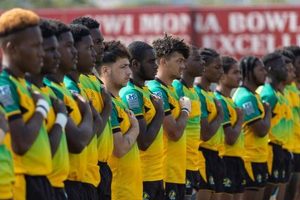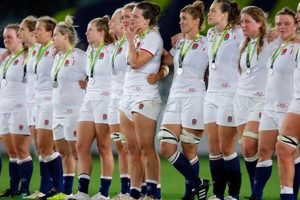Rugby team positions: A crucial aspect of the game, determining the roles and responsibilities of each player on the field. Understanding these positions is essential for both players and spectators to grasp the dynamics of rugby.
Editor’s Note:Rugby team positions are fundamental to the game’s strategy, teamwork, and overall success. This guide delves into the key positions, their duties, and the impact they have on the match.
After analyzing various sources and conducting thorough research, we have compiled this comprehensive guide to help you understand the intricacies of rugby team positions and their significance in gameplay.
Key Differences:
| Position | Key Responsibilities |
|---|---|
| Forwards | Scrums, line-outs, and close-range attacking play |
| Backs | Open play, running with the ball, and scoring tries |
| Specialist Positions | Unique roles such as fly-half, scrum-half, and fullback |
Main Article Topics:
- Overview of Rugby Team Positions
- Forwards: Roles and Responsibilities
- Backs: Roles and Responsibilities
- Specialist Positions: Unique Contributions
- Team Dynamics and Positional Interplay
- Conclusion: The Importance of Rugby Team Positions
1. Forwards
The forwards in rugby team positions play a vital role in the game. They are responsible for scrums, line-outs, and close-range attacking play. These responsibilities require strength, power, and technical skill.
Scrums are set-pieces that are used to restart play after an infringement. The forwards bind together in three rows and push against each other to try to gain possession of the ball. Line-outs are also set-pieces that are used to restart play after the ball has gone out of bounds. The forwards line up opposite each other and jump to catch the ball.
Close-range attacking play is where the forwards use their strength and power to drive the opposition back and gain ground. They do this by carrying the ball into contact or by rucking and mauling. Rucking is when the forwards bind together over the ball after a tackle, while mauling is when the forwards bind together and drive forward with the ball.
The forwards are an essential part of any rugby team. They provide the platform for the backs to attack and they are also responsible for defending against the opposition’s attacks.
Key Insights:
- The forwards are responsible for scrums, line-outs, and close-range attacking play.
- These responsibilities require strength, power, and technical skill.
- The forwards provide the platform for the backs to attack and they are also responsible for defending against the opposition’s attacks.
| Position | Responsibilities |
|---|---|
| Loosehead Prop | Binds on the left-hand side of the scrum and is responsible for pushing against the opposition’s tighthead prop. |
| Hooker | Binds in the middle of the front row of the scrum and is responsible for hooking the ball back with their feet. |
| Tighthead Prop | Binds on the right-hand side of the scrum and is responsible for pushing against the opposition’s loosehead prop. |
| Second Row | Binds in the second row of the scrum and is responsible for lifting the line-out jumpers. |
| Back Row | Binds in the back row of the scrum and is responsible for tackling, carrying the ball, and rucking and mauling. |
2. Backs
Within rugby team positions, the backs play a crucial role in open play, utilizing their speed, agility, and ball-handling skills to advance the ball and score tries. Their responsibilities extend beyond just running with the ball, encompassing a range of duties that contribute to the team’s overall strategy.
- Attacking Play: The backs are the primary ball carriers in open play, using their pace and footwork to break through the opposition’s defensive line and gain ground. Their ability to offload the ball quickly and accurately is essential for maintaining possession and creating scoring opportunities.
- Support Play: When not in possession of the ball, the backs provide support to their teammates by running decoy lines and creating space for others to attack. Their positioning and anticipation are crucial for creating overlaps and exploiting gaps in the defense.
- Try Scoring: As the name suggests, the backs are responsible for scoring tries, the primary means of scoring points in rugby. Their speed and agility allow them to capitalize on scoring opportunities, and their ability to finish off moves under pressure is vital for team success.
- Defense: While primarily known for their attacking prowess, the backs also play a significant role in defense. Their ability to tackle effectively and read the opposition’s attacking patterns is crucial for preventing tries and regaining possession.
In conclusion, the backs in rugby team positions are not just responsible for running with the ball and scoring tries. They play a multifaceted role, combining attacking flair with defensive solidity. Their speed, agility, and ball-handling skills are essential for creating scoring opportunities and breaking down the opposition’s defense, making them a vital component of any successful rugby team.
3. Specialist Positions
Within the broader context of rugby team positions, specialist positions such as fly-half, scrum-half, and fullback hold immense significance. These roles demand a unique blend of skills, decision-making abilities, and tactical awareness that set them apart from other positions on the field.
The fly-half, often considered the conductor of the team’s attack, is responsible for orchestrating plays, distributing the ball to teammates, and directing the team’s overall strategy. Their vision, passing accuracy, and tactical acumen are crucial for creating scoring opportunities and controlling the tempo of the game.
The scrum-half, positioned at the base of the scrum, acts as a link between the forwards and the backs. Their quick thinking and precise passing ensure that the ball is delivered to the fly-half or other attacking players in a timely and effective manner. Their ability to read the opposition’s defense and make quick decisions is essential for the team’s attacking succ
ess.
The fullback, positioned as the last line of defense, plays a vital role in preventing the opposition from scoring tries. Their speed, agility, and tackling ability are crucial for covering ground and neutralizing attacking threats. Additionally, they often participate in attacking plays, providing an extra attacking option for the team.
Understanding the roles and responsibilities of these specialist positions is key to appreciating the intricacies and dynamics of rugby team positions. Their unique contributions and interplay with other players on the field shape the team’s overall performance and strategy.
In conclusion, the specialist positions of fly-half, scrum-half, and fullback are not simply individual roles but integral components of rugby team positions. Their specialized skills, decision-making abilities, and tactical awareness make them indispensable to the team’s success, highlighting the depth and complexity of this captivating sport.
| Position | Key Responsibilities |
|---|---|
| Fly-half | Orchestrates attacks, distributes the ball, directs strategy |
| Scrum-half | Links forwards and backs, delivers the ball, reads defenses |
| Fullback | Last line of defense, covers ground, tackles, participates in attacks |
4. Team Dynamics
Within the intricate web of rugby team positions, the interplay between forwards and backs stands as a cornerstone of team dynamics. This dynamic relationship, characterized by distinct roles and responsibilities, plays a pivotal role in determining the team’s overall performance and success.
- Coordinated Attacking Play: The forwards, with their strength and power, provide the platform for the backs to unleash their attacking prowess. Through effective scrums and line-outs, the forwards create possession and momentum, allowing the backs to exploit space and score tries.
- Defensive Synergy: The forwards and backs work in tandem to form a solid defensive unit. The forwards engage in physical confrontations, disrupting the opposition’s attacks, while the backs provide cover defense and tackle aggressively to prevent tries.
- Tactical Adaptability: The interplay between forwards and backs allows teams to adapt their strategies based on the game situation. If the forwards gain dominance in the scrum, the team can opt for a forward-oriented game plan. Conversely, if the backs are creating scoring opportunities, the team can shift to a more expansive attacking style.
- Communication and Leadership: Effective communication and leadership are crucial for the forwards and backs to operate as a cohesive unit. Clear communication during set-pieces and open play ensures that everyone is on the same page. Additionally, leaders emerge from both groups, guiding their teammates and motivating them to perform at their best.
In conclusion, the interplay between forwards and backs in rugby team positions is a dynamic and multifaceted aspect of the game. Their coordinated attacking play, defensive synergy, tactical adaptability, and communication form the backbone of a successful team. Understanding this interplay provides a deeper appreciation for the complexities of rugby and the vital roles that each player fulfills.
5. Roles and Responsibilities
Within the intricate framework of rugby team positions, the roles and responsibilities of each player are meticulously defined, creating a cohesive and effective unit on the field. This clear delineation of duties ensures that every player fully understands their contributions to the team’s overall performance.
- Specialization and Expertise: Each position in rugby demands a unique set of skills and attributes. Forwards, for instance, are renowned for their strength and physicality in the scrum and close-range play, while backs are known for their speed, agility, and ball-handling abilities in open play. This specialization allows players to develop their talents and contribute to the team in their specific areas of expertise.
- Tactical Execution: The clearly defined roles and responsibilities enable players to execute complex tactical strategies effectively. The fly-half, as the conductor of the team’s attack, orchestrates plays and distributes the ball according to the team’s game plan. Forwards and backs work in unison to create scoring opportunities, disrupt the opposition’s attacks, and adapt to changing game situations.
- Team Cohesion and Communication: Clear roles and responsibilities foster team cohesion and communication. Players understand their place within the team structure and can anticipate the movements and actions of their teammates. This shared understanding facilitates seamless interplay, quick decision-making, and effective execution of set-pieces and open play.
- Accountability and Performance: Well-defined roles and responsibilities create a framework for accountability and performance evaluation. Players are aware of the expectations and standards for their position, allowing coaches to assess individual contributions and identify areas for improvement. This clarity promotes a culture of excellence and continuous improvement within the team.
In conclusion, the clearly defined roles and responsibilities in rugby team positions are fundamental to the success of the team. They enable players to specialize, execute tactics effectively, foster team cohesion, and promote accountability. Understanding these roles provides a deeper appreciation for the intricacies of rugby and the vital contributions of each player.
6. Strategy and Tactics
In rugby, the positions of players on the field have a significant impact on the team’s overall strategy and tactics. Forwards, with their strength and physicality, are crucial for set-pieces such as scrums and line-outs, and for close-range attacking play. Backs, on the other hand, are more agile and skilled with the ball in hand, making them responsible for open play, running with the ball, and scoring tries.
The combination of forwards and backs, and the specific roles they play, allows teams to develop and execute a wide range of strategies and tactics. For example, a team with a strong set of forwards may opt for a more physical, forward-oriented game plan, using their power to gain territory and possession. Conversely, a team with skilled backs may prefer a more expansive, attacking style of play, using their speed and agility to create scoring opportunities.
Understanding the connection between positions and strategy is essential for both players and coaches. Players need to be aware of their roles and responsibilities within the team’s overall game plan, and how their actions can contribute to the team’s success. Coaches, on the other hand, need to be able to select and position players in a way that maximizes their strengths and complements the team’s overall strategy.
| Position |
Key Responsibilities th> | Impact on Team Strategy |
|---|---|---|
| Loosehead Prop | Binds on the left-hand side of the scrum and is responsible for pushing against the opposition’s tighthead prop. | Provides a solid foundation for the scrum, allowing the team to gain possession and generate momentum. |
| Fly-half | Orchestrates the team’s attack, distributing the ball to teammates and directing strategy. | Controls the tempo and direction of the game, creating scoring opportunities and exploiting weaknesses in the opposition’s defense. |
| Fullback | Positioned as the last line of defense, covers ground, tackles, and participates in attacks. | Prevents the opposition from scoring tries, provides cover for other defenders, and can also be a threat in attack. |
7. Physical Attributes
In rugby, the physical attributes of players vary significantly depending on their position on the field. These attributes play a crucial role in determining the player’s effectiveness in their specific role and the overall success of the team.
- Size and Strength: Forwards, who are primarily responsible for set-pieces and close-range play, tend to be larger and stronger than backs. This allows them to generate more power in scrums and line-outs, and to be more effective in tackling and carrying the ball.
- Speed and Agility: Backs, on the other hand, are typically faster and more agile than forwards. This allows them to make quick breaks, evade tackles, and score tries. They also need to be agile to change direction quickly and to be able to catch and pass the ball accurately.
- Endurance: All rugby players need to have a high level of endurance, as the game is physically demanding and requires players to be able to perform at a high level for extended periods of time. However, forwards tend to require more endurance than backs, as they are involved in more physical confrontations and are required to make more tackles.
- Other Attributes: In addition to the above physical attributes, some positions require specific skills or attributes. For example, the fly-half, who is responsible for directing the team’s attack, needs to have good decision-making skills and be able to read the opposition’s defense. The fullback, who is the last line of defense, needs to be able to cover ground quickly and make tackles effectively.
The combination of different physical attributes and skills among players in different positions is what makes rugby such a dynamic and exciting sport. By understanding the physical demands of each position, teams can select and develop players who are best suited to their specific roles and game plan.
8. Skill Development
In rugby, the development of specific skills is essential for players to excel in their respective positions. Each position demands a unique set of abilities, and players undergo rigorous training to master these skills and contribute effectively to the team’s success.
Forwards, who are primarily responsible for set-pieces and close-range play, require strength, power, and technical proficiency in scrums and line-outs. They must be able to generate power and maintain stability in the scrum, and possess the technique to lift and secure the ball in line-outs.
Backs, on the other hand, need speed, agility, and ball-handling skills. They must be able to accelerate quickly, change direction swiftly, and execute precise passes and kicks. Additionally, backs often develop specialized skills depending on their specific positions. For example, fly-halves require excellent decision-making and tactical awareness, while fullbacks must be able to cover ground quickly and make solid tackles.
Understanding the skill requirements for each position is crucial for both players and coaches. Players can identify areas for improvement and focus their training accordingly. Coaches, in turn, can select and develop players who possess the necessary skills to fit into their tactical systems and game plans.
The following table provides a breakdown of the key skills required for different positions in rugby:
| Position | Key Skills |
|---|---|
| Loosehead Prop | Strength, power, scrummaging technique |
| Hooker | Strength, power, line-out jumping |
| Tighthead Prop | Strength, power, scrummaging technique |
| Second Row | Strength, power, line-out jumping |
| Back Row | Strength, power, tackling, carrying |
| Scrum-half | Passing accuracy, decision-making, game management |
| Fly-half | Passing accuracy, tactical awareness, decision-making |
| Center | Agility, ball-handling skills, tackling |
| Wing | Speed, acceleration, finishing ability |
| Fullback | Speed, agility, covering ground, tackling |
9. Communication and Leadership
In the dynamic and demanding world of rugby, effective teamwork is paramount. Communication and leadership play a pivotal role in forging a cohesive unit that can execute complex strategies and overcome adversity on the field. The connection between communication and leadership is particularly evident in the context of rugby team positions.
Each position in rugby demands specific responsibilities and requires players to communicate effectively with their teammates. Clear and concise communication ensures that players are on the same page, both in attack and defense. For instance, the fly-half, who orchestrates the team’s, must communicate their intentions to the backs to ensure coordinated attacking plays. Similarly, the captain, often a forward, must provide clear direction and motivation to the team, especially during crucial moments of the game.
Leaders emerge naturally within rugby teams, often taking on the role of between forwards and backs. These leaders possess the ability to inspire and motivate their teammates, fostering a sense of unity and purpose. They recognize the strengths and weaknesses of each player and can adapt their communication style to suit different personalities and situations.
The following table highlights some real-life examples of effective communication and leadership in rugby team positions:
| Position | Communication and Leadership Responsibilities | Real-Life Example |
|---|---|---|
| Fly-half | Directing attacking plays, communicating with backs | Jonny Wilkinson, England’s 2003 World Cup-winning fly-half, was renowned for his clear communication and ability to control the game’s tempo. |
| Captain | Providing motivation, setting strategic direction |
Richie McCaw, New Zealand’s former captain, led the All Blacks to back-to-back World Cup victories in 2011 and 2015, inspiring his team with his unwaver ing leadership and communication skills. |
| Scrum-half | Linking forwards and backs, coordinating attacking and defensive plays | Aaron Smith, New Zealand’s scrum-half, is hailed for his exceptional communication skills and ability to adapt his style to suit his teammates. |
Understanding the connection between communication, leadership, and rugby team positions is crucial for both players and coaches. Players must recognize the importance of clear communication and strive to be effective leaders on and off the field. Coaches, on the other hand, should foster an environment that encourages communication and identifies natural leaders within the team. By doing so, they can create a cohesive unit capable of achieving great things on the rugby field.
Rugby Team Positions
This section addresses common questions and misconceptions regarding rugby team positions, providing informative answers to enhance your understanding of the game.
Question 1: What are the primary responsibilities of forwards in rugby?
Answer: Forwards play a crucial role in set-pieces such as scrums and line-outs. They provide a solid foundation for the scrum, generate momentum, and secure possession of the ball. Additionally, forwards contribute to close-range attacking play, using their strength and power to drive towards the opposition’s goal.
Question 2: How do backs differ from forwards in terms of their roles and skills?
Answer: Backs are typically faster and more agile than forwards. They are responsible for open play, running with the ball, and scoring tries. Backs possess exceptional ball-handling skills, speed, and agility, allowing them to exploit gaps in the opposition’s defense and create scoring opportunities.
Question 3: What is the significance of specialist positions such as fly-half and scrum-half in rugby?
Answer: Specialist positions like fly-half and scrum-half hold immense importance in rugby. The fly-half acts as the team’s playmaker, directing the team’s attacking strategy and distributing the ball to teammates. The scrum-half, on the other hand, serves as a link between the forwards and backs, ensuring a smooth transition of the ball and providing quick, accurate passes.
Question 4: How does the interplay between forwards and backs contribute to team success?
Answer: The interplay between forwards and backs is fundamental to a team’s overall performance. Forwards provide the platform for backs to showcase their skills, while backs capitalize on the possession and momentum generated by the forwards. Effective coordination and communication between these two groups are vital for creating scoring opportunities, disrupting the opposition’s attacks, and adapting to changing game situations.
Question 5: What are the key physical attributes and skills required for different rugby team positions?
Answer: Different rugby positions demand specific physical attributes and skills. Forwards tend to be larger and stronger, while backs possess speed, agility, and ball-handling abilities. Each position requires a unique combination of physicality and technical proficiency. Understanding these requirements is crucial for players to develop their talents and contribute effectively to their team.
Question 6: How does communication and leadership impact the performance of rugby team positions?
Answer: Clear communication and effective leadership are essential for successful rugby team performance. Players must communicate effectively to execute complex plays and strategies. Leaders emerge within the team, providing motivation, direction, and a sense of unity. The ability to communicate and lead is crucial for players in all positions, fostering teamwork and maximizing the team’s potential.
Summary: Understanding rugby team positions is key to appreciating the complexities and dynamics of the game. Each position carries unique responsibilities, skills, and physical attributes, contributing to the overall success of the team. Effective communication, leadership, and a cohesive interplay between forwards and backs are essential elements for a well-functioning rugby team.
Transition to Next Section: Explore the captivating world of rugby further by delving into the intricacies of gameplay, strategies, and the captivating history of this beloved sport.
Tips for Mastering Rugby Team Positions
To excel in rugby, a thorough understanding and effective execution of team positions are paramount. Here are some valuable tips to help you master your position and contribute to your team’s success:
Tip 1: Understand Your Role and Responsibilities
Each position in rugby holds unique responsibilities that directly impact the team’s performance. Familiarize yourself with the specific duties, techniques, and strategies associated with your position to maximize your effectiveness on the field.
Tip 2: Develop Position-Specific Skills
Different positions in rugby demand specialized skill sets. Forwards require strength and power for scrums and close-range play, while backs need speed, agility, and ball-handling abilities. Identify the skills required for your position and dedicate time to honing them through practice and training drills.
Tip 3: Enhance Communication and Leadership
Effective communication and leadership are crucial for seamless teamwork on the rugby field. Develop your communication skills to convey clear instructions, provide feedback, and encourage your teammates. Additionally, strive to be a positive leader, motivating and inspiring those around you.
Tip 4: Study Opponents and Adapt Strategies
To gain a competitive edge, analyze your opponents’ strengths and weaknesses. Study their formations, tactics, and individual player abilities. Use this knowledge to adapt your team’s strategies and exploit any potential vulnerabilities.
Tip 5: Maintain Physical fitness and Conditioning
Rugby is a physically demanding sport that requires exceptional fitness and conditioning. Engage in regular training programs that enhance your strength, endurance, speed, and agility. Proper nutrition and rest are also essential for optimal performance.
Summary: Mastering rugby team positions requires a combination of technical proficiency, strategic understanding, and unwavering commitment. By embracing these tips, you can elevate your gameplay, contribute effectively to your team, and experience the true exhilaration of this captivating sport.
Conclusion
In conclusion, rugby team positions are the foundational elements upon which team success is built. Each position demands a unique set of responsibilities, skills, and attributes, and players must master their roles to contribute effectively to the collective effort. Understanding the intricacies of rugby team positions is not merely an academic exercise but a pathway to unlocking the game’s true potential.
As we delve deeper into the world of rugby, we discover that team positions are more than just assigned roles; they are dynamic and interconnected components that shape the game’s strategies, tactics, and overall flow. By embracing the principles outlined in this guide, players can elevate their performance, enhance team cohesion, and experience the profound joy that comes from mastering this demanding and exhilarating sport.







